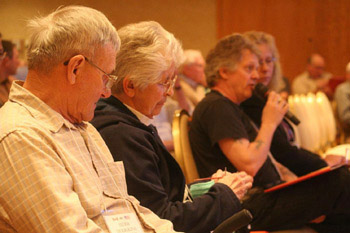LIMITED ENTRY, YOUNG WANT IN, SENIORS OUT
continued from Home Page

From left, lobster industry leader Herb Hodgkins, his wife Pat, and Downeast Lobstermen’s Association leaders Michael and Sheila Dassatt attend the March 23-24 Canadian/U.S. Lobstermen’s Town Meeting in Portland. Laurie Schreiber Photo
Industry leaders led the discussion on various systems in Maine, Massachusetts and Canada. Maine has entry and exit programs for students and apprentices, and for older fishermen getting ready to retire, that may need some tweaking to stabilize the fishery and resource. But Maine has been successful at maintaining its lobster fishery at the homegrown, community level.
Maine’s neighbors in Canada also seek to maintain the community feel of their fishery. But, for some, the ability to sell lobster licenses has resulted in outsize prices that make it difficult for young fishermen to get started in the industry, and threatens communities with the prospect of seeing their fishery taken over by large corporations.
By contrast, the transfer and sale of permits to new fishermen is also allowed in Massachusetts, but prices have remained within reach.
Grand Manan Island fisherman Laurence Cook, chairman of the Grand Manan Fishermen’s Association’s (GMFA) Lobster Committee, discussed license transferability in Canada, where licenses are considered property.
Grand Manan is a Canadian island that is the largest in the Bay of Fundy. Sitting at the boundary between the Bay of Fundy and the Gulf of Maine, the 53-square-mile island is actually closest to the mainland on the Maine side of the international border, just nine miles from Lubec across the Grand Manan Channel.
Cook said that Canada has had limited entry to the fishery for 50 years. The management system divides the Canadian fishery into districts—the Grand Manan district is Lobster Fishing Area (LFA) 38, which is currently allotted 136 licenses, he said.
“The big problem now with transferability is the price,” he said. “The cost of buying a license has changed dramatically. As an example, when I started out, I bought a boat, 375 traps—which is all you’re allowed—a handline license, and a lobster license for $36,000 – and everybody said I paid too much.”
In recent years, he said, LFA 38 has seen licenses transfer for $650,000. A license in Nova Scotia sold for $1 million “for the piece of paper alone, without the boat,” he said. “Prices have settled back in our area to about $300,000 for the piece of paper.”
The problem for young, would-be fishermen, he said, is finding the financing.
“It’s impossible nowadays for a young person to walk into a bank and secure the financing to buy a lobster boat,” Cook said. “If you take $300,000 for the license and then have to pay for the boat and traps, you’re talking about a half-million dollars before you’re in the water.”
The problem also means that senior fishermen who aim to retire are having trouble finding fair prices for their vessels, he said.
The situation was recently complicated, he said, when the government purchased back 20 Grand Manan licenses to give to native Canadians, in accordance with a 1999 decision by the Supreme Court of Canada that upheld native fishing rights.
Cook said the GMFA is upset by another recent government decision to sell a lobster license outside LFA 38 to a company from the Yarmouth, N.S., area. The Nova Scotia resident is now allowed to fish in LFA 38, he explained. GMFA has called for a freeze on the sale of lobster fishing to non-residents, he said.
The situation, he said, was “a great concern for us because it increases the price of the license, which is good for the guy selling out but very bad for young people trying to get into the fishery.”
Cook said the combined circumstances have been a hard hit on the Grand Manan economy. Each lobster license, he said, represents about 1 percent of the Grand Manan economy.
“Every license that leaves is a hard shot at our community, making it that much more difficult for every business on the island because we are the driving mechanism,” Cook said of the lobster industry. “So while we want our system open and as free as possible for new entrants, we also want to keep the revenue that comes out of the ocean adjacent to our land, on our land.”
Ken Drake, a member of the Prince Edward Island Fishermen’s Association, said many of the issues are similar in his province, where there are three LFAs.
“Our provincial government decided a few years ago to look at incentives for younger people to get into fishery,” Drake said. “We’re an aging population” with the majority of fishermen between the age of 55 and 65, “so the future of the fishery is going depend a lot on incentives for younger people.”
To that end, Drake said, Prince Edward Island’s Department of Fisheries, Aquaculture and Rural Development in 2009 developed a “Future Fisher Program” to provide training and financial assistance to young fishermen. So far, about 40 young fishermen have been through the program, which also provides a low-interest loan program both for new and long-time fishermen. The government recently agreed to extend the program for four years, he said.
Drake said that the idea of a non-family corporation being allowed to buy licenses, as happened on Grand Manan, is new to the fishery. Canada’s transferable licenses make them valuable, he said. But the goal is to keep them within affordable reach of average fishermen.
“We have an owner/operator policy. We want it to stay that way,” Drake said. “We don’t want licenses to transfer to large organizations. Small communities are living off this. And the spin-off for small communities are the same anywhere. It can go family-corporate, and that’s a great way for me to retire and to hand it over to my children. I don’t have anything against family-owned corporations. This is about the fear of large industries taking over and starting to control the industry.”
Bill Adler, executive director of the Massachusetts Lobstermen’s Association, said that fishermen in his state can also transfer “coastal inshore” lobster licenses along with lobster-related business assets. That program started in the 1990s, he said, when Massachusetts closed the lobster fishery to all new entrants. At the time, there were about 1,800 licenses.
“It was determined that we needed a way to let people who wanted to get out, to get out, and to let people in,” Adler said.
He said that a concomitant mandatory catch-reporting law allowed the industry to track when fishermen stopped fishing; this resulted in the retirement of licenses and the number of coastal lobster fishermen was lowered, as planned. Today, there are about 1,300 licenses, he said.

Laurence Cook, left – chairman of the Grand Manan Fishermen’s Association’s Lobster Committee; and Yarmouth ME lobster fisherman Elliott Thomas. Laurie Schreiber Photo
“There are no new coastal permits being issued, but people can sell their licenses,” Adler said. “It’s worked very well. The license has to have been active four out of past five years. There are requirements for what ‘active’ means. The person coming in has to have had experience. And it has not gone out of control price-wise, when you look at the license and the boat.”
Adler said that Massachusetts took action to limit entry to the fishery in response to the growing number of licenses issued in the 1980s.
“The biologists at that time indicated that they thought the number of fishermen in the coastal waters should be a lot lower,” Adler said.
Yarmouth lobster fisherman Elliott Thomas, a member of the Maine Lobstermen’s Association’s board of directors, said that Maine’s system “is quite a bit different.” Maine fishermen do not own their licenses and can’t transfer them.
“Since 1998, commercial lobster licenses have only been available to those who had them the year before or those who entered the apprentice or student systems. To obtain a license you have to go through one of these systems,” Thomas said.
Maine is currently assessing the costs and benefits of its limited entry system, thanks to an independent analysis that was commissioned by the Department of Marine Resources (DMR) under the direction of the legislature. The study stemmed from concerns in recent years regarding the resource’s ability to sustain a boom in the number of traps in the water.
“We went from 2.1 million tags up to 3.1 million tags,” said DMR lead lobster biologist Carl Wilson. “Most of that increase, in last 15 years, came from eastern half of Maine. And that changes the whole dynamic, how you discuss tags in and tags out.”
Casco Bay fisherman Steve Train said that, in the eastern half of Maine, reductions in the trap limit did not result in a reduction in “real effort.”
“A lot of us in Casco Bay reduced half or more of our traps to go to the 800-trap limit, and there are more actual traps in the water in Casco Bay now than there were 20 years ago,” Train said.
The discussion was only one item of the town meeting’s agenda. Other topics were marine debris and derelict traps, whale take reduction updates, bait quality, aquaculture, and offshore wind turbines.
The Lobster Institute, which coordinated its first lobstermen’s town meeting in 2004, provides a communication link among lobster harvesters, dealers, pound owners, processors, scientists and resource managers. It has initiated or supported research focusing on lobster health, biology, ecology, and economics and has sponsored numerous conferences and seminars.
The town meeting started “as a way to get fishermen in the U.S. and Canada together, to get them talking,” said the institute’s director, Bob Bayer. “We just thought there were so many common issues, we would bring them together and see what happens. We began with a basic distrust on both sides of the border, but it’s developed into a real trust as a result of doing this.”
The town meeting’s agenda is set by the industry, he said. The primary topic of the first year’s meeting was the environment, with a focus on ocean acidification and its impacts on the fishery. The environment, bait, whale take reduction, and market issues have remained top items on agendas since then. The meetings provide common ground for fishermen from both countries, said Drake, who co-chaired this year’s meeting.
“Ongoing relationships develop here—fishers, buyers, processors, bait dealers, everybody in the industry—and you get to hear their perspectives,” Drake said. “A lot of times, you sit around at the wharf and you hear, ‘Oh, this guy is ripping me off something terrible.’ When you find out what his costs are and that he’s just surviving the same as you are, then you’re more satisfied that you have a better understanding. And I think that’s something that doesn’t happen at most meetings. At most meetings you have someone aggressive, something gained or lost. But here, I think, everybody gains. I think it’s an input where people don’t have to hold back for fear somebody’s going to gain information that’s harmful to you later on.”
As always, the Canadian/U.S. Lobstermen’s Town Meeting was recorded and the Lobster Institute will make a CD or written reports available to interested parties. In addition, a summary report and full transcript are available at lobsterinstitute.org.
For more information, contact Deb Seekins at 207-581-1443 or deb.seekins@umit.maine.ed.
http://en.wikipedia.org/wiki/Canada
http://en.wikipedia.org/wiki/Bay_of_Fundy
http://en.wikipedia.org/wiki/Gulf_of_Maine
